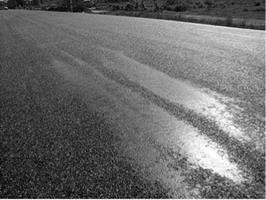LONGITUDINAL FAT SPOTS OF BINDER
Longitudinal fat spots are the most frequently seen defects when using SMA. Such spots may be defined as areas with an excess of binder or mastic that are shaped longitudinally and are parallel to the path of the paver.
There are two types of longitudinal fat spots—binder fat spots and mastic fat spots—which differ only in the content of the fat spot’s components.
Longitudinal fat spots (Figure 11.1) contain, firstly, some amount of binder appearing on the surface of a course. They are easily recognizable simply by scratching the fat spot with the metal stem of a thermometer. A thin binder layer
|
FIGURE 11.1 Longitudinal fat spots of binder. (Photo courtesy of Bartosz Wojczakowski.) |
is visible on the surface of the SMA course, with regular SMA underneath. Thus such fat spots are similar in appearance to mastic fat spots but with no separation of all the mastic from the coarse aggregates. They arise because of an excess of unbonded binder. They may be caused by an error during one (or more) of the following:
• Design (too much binder designed in SMA)—this type of error should be detected by the design laboratory during draindown testing; thus it happens relatively rarely.
• Production—it is more likely that an overdosage of binder will occur during mixture production (e. g., due to an inaccurate weigh scale for the binder) or because the metered amount of stabilizer proved to be too small to prevent binder draindown—that is, an inaccurate stabilizer metering system or inadequate action from the stabilizer (e. g., a granulated stabilizer of poor quality or one damaged by an excessive time of dry mixing[66]).
• Change in the properties of the components—this can occur any time a component is changed during the course of SMA manufacture.
• Fillers are changed and have significantly different contents of voids than previous fillers.
• PMB viscosity is too low at the production and laying temperatures (occurs especially when PMB is used for an SMA without fibers).
• Granulated stabilizer quality changes or is overpressed.
• Surface preparation—in some circumstances an excess of binder coming from an underlying tack coat (which may result from excess tack coat binder gathering in depressions) or mastic asphalt patches situated under SMA may be drawn up into the SMA surface by the heat of the newly placed course.







Leave a reply